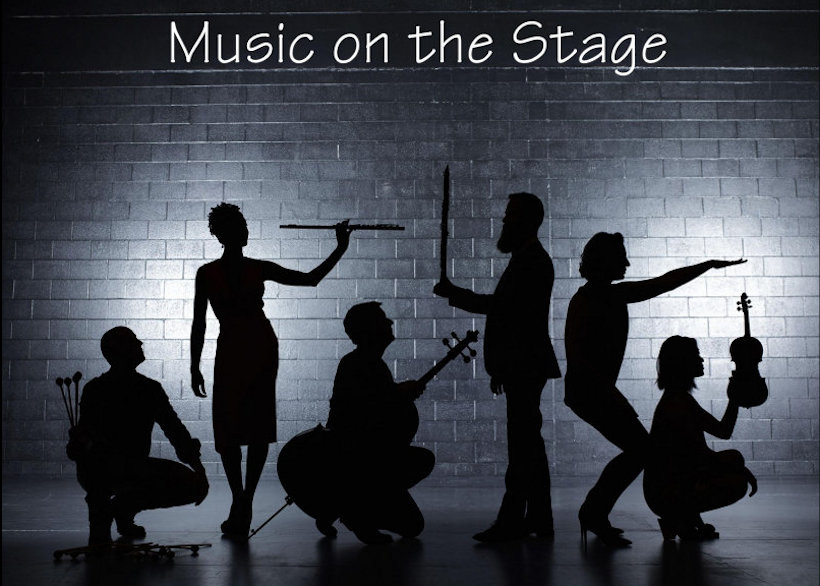1. Our Revels Now.
As this course is about music in a dramatic context, it seemed easiest to start by looking at the various ways in which music can
function in the context of an actual play—The Tempest, Shakespeare’s most musical—and how those functions may be
extended in later adaptations and different media. The two main forms in which music enters a play—as dance and song—correspond
to the two most fudamental ways in which human beings connect to music. To some extent this duality will form an organizing
principle for this class and the course as a whole.
Those whose memory of The Tempest is hazy will be relieved to know that only one strand of the plot is relevant to the
present class. Prospero, the former Duke of Milan, has been usurped by his unscrupulous brother in league with the King of Naples.
He has fled with his infant daughter Miranda and a selection of his books to a deserted island, where he has used his magical
powers to dominate the inhabitants, including the spirit Ariel and slave Caliban. Now, many years later, he sets the stage for
the denouement. He gets Ariel to conjure up a storm to wreck a ship carrying his brother and the King of Naples, and cast
everybody up on shore, unharmed, but believing that all the others have been drowned. The first survivor we see is the handsome
Ferdinand, heir to the throne of Naples. After undergoing trials set by Prospero, he will eventually marry Miranda. A fuller
synopsis and the complete text of the play can be found
here.
The script, videos, and images will be posted immediately after class.
Because my daughter's family had been dealing with COVID, and I feared that I might not be able to give the class
in person, I made a recording of the whole thing. In the event, I did come down, but since this class lays the
groundwork for everything else, I have uploaded it temporarily to YouTube; I hope it may be useful for anybody
who missed the first class, or those who want to review it. It is in seven sections of around 10 minutes each.
Click
here for the first one, which should bring up a playlist of all the others.
Unfortunately, the two main productions of the play that I showed (Globe 2013 and RSC 2016) are available only on DVD; I have
substituted a trailer of each, but there is a lot more out there if you care to look. Links to all other videos are below. rb.
| |
|
|
|
|
|
| IMAGES |
The thumbnails below cover the slides shown in class, though
there may be a few small discrepancies. Click the thumbnail to see a larger image.
Click on the right
or left of the larger picture to go forward or back, or outside it to close. |
 | |
 | |
 | |
 | |
 | |
 | |
 | |
 | |
 | |
 | |
 | |
 | |
 | |
 | |
 | |
 | |
 | |
 | |
 | |
 | |
 | |
 | |
 | |
 | |
 | |
 | |
 | |
 | |
 | |
 | |
 | |
 | |
 | |
Here are brief bios of the artists, composers, and writers considered in the class, listed in order of birth.
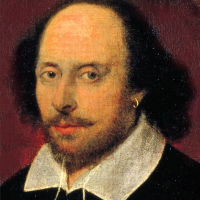 |
William Shakespeare, 1564–1616. English poet and playwright.
With almost 40 plays, 154 sonnets, and many longer poems, Shakespeare dominates English literature of his time, and world literature for ever after. To attempt a thumbnail biography would be both unnecessary and impossible.
|
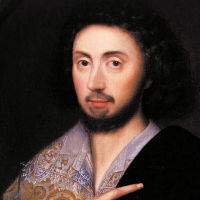 |
Robert Johnson, 1583–1633. English composer.
A lutenist and composer of the late Tudor and early Jacobean eras, Johnson wrote music for many masques and several of Shakpespeare's later plays. [The image, though in period, is not Johnson's portrait.]
|
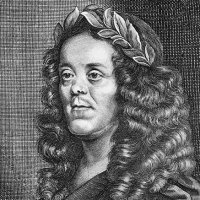 |
William Davenant, 1606–68. English playwright.
Davenant claimed to be Shakespeare's natural son, but it is less unlikely that he was his godson. He was appointed Poet Laureate by Charles I, spent much of the Interregnum in exile or prison, then returned to favor in the Restoration as impresario of one of the two Royal Theatres. His adaptation of The Tempest with John Dryden (his successor as Poet Laureate) set the fashion for presentation of Shakespeare for two centuries. Though produced privately, his Siege of Rhodes (1656) is the first English opera.
|
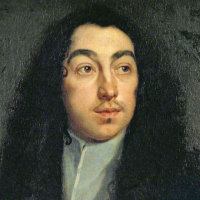 |
Matthew Locke, 1630–77. English composer.
Though he worked in several genres and was a noted theorist, Locke wrote theatre music for plays by Davenant including his opera The Siege of Rhodes and his adaptation of The Tempest.
|
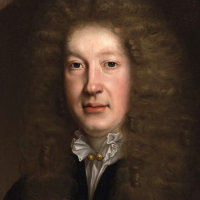 |
John Dryden, 1631–1700. English poet.
Poet laureate of the United Kingdom 1668–88, Dryden dominated the Restoration theater and literary scene. He was the most important contributor (though posthumous) to the translation of the Metamorphoses issued by Samuel Garth in 1717. He collaborated with Davenant on an adaptation of The Tempest that returned Shakespeare to the Restoration stage in modified but triumphant guise.
|
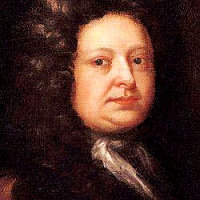 |
Thomas Shadwell, 1642–92, . English playwright.
A poet and prolific playwright, he superseded his enemy John Dryden as Poet Laureate in 1688 when his party, the Whigs, came into power. He was responsible for commissioning composers such as Locke and Weldon to turn the Davenant/Dryden version of The Tempest into an opera, The Enchanted Island.
|
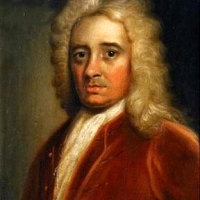 |
John Weldon, 1676–1736. English composer.
Weldon was a pupil of Henry Purcell and was probably the actual composer of the 1695 Tempest adaptation The Enchanted Island more commonly associated with his mentor.
|
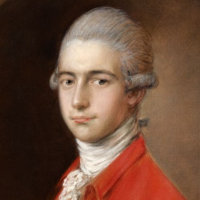 |
Thomas Linley the Younger, 1756–78. English composer.
Sometimes referred to as "the English Mozart," his contemporary Linley also showed prodigious talent as a composer and performer (on the violin), but died even younger, of a boating accident at age 24.
|
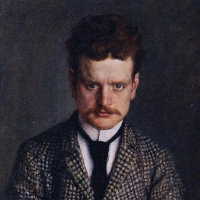 |
Jean Sibelius, 1865–1957. Finnish composer.
Sibelius "is widely regarded as his country's greatest composer, and his music is often credited with having helped Finland develop a national identity during its struggle for independence from Russia" [Wikipedia]. In addition to his seven symphonies, at least two of which have become repertoire standards, he wrote a number of tone poems based on Finnish history and myth, such as Finlandia, Tapiola, the Lemminkainen Legends, and the Karelia Suite.
|
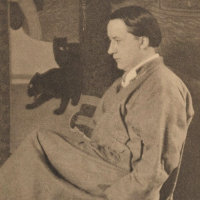 |
Edmund Dulac, 1882–1953. French-British artist.
Although he worked in many media, Dulac's imagination, use of color, and study of Asian art made him especially popular as a book-illustrator of legendary and fantastic subjects, including Shakespeare's Tempest, perhaps his most famous work.
|
 |
Lee Hoiby, 1926–2011. American composer.
Hoiby studied with Gian Carlo Menotti at the Curtis Institute, and took up a similar career in opera, writing music whose accessible lyricism bucked the prevailaing trend. His most famous work is probably his 1971 adaptation of Tennessee Williams's Summer and Smoke, with libretto by Lanford Wilson. He also worked with his life partner Mark Schulgasser on an adaptation of The Tempest which achieved some success in 1986.
|
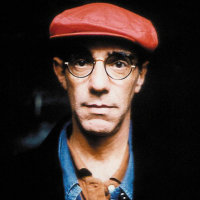 |
Derek Jarman, 1942–94. English film-maker and designer.
After training at the Slade School in London, Jarman began his career as a stage designer, including major projects in opera and ballet. His stage collaborations with Ken Russell led to his work in film, which included numerous experimental works, music videos, and a beautiful rendering of Benjamin Britten's War Requiem. A lifelong gay activist, he died of AIDS in 1994.
|
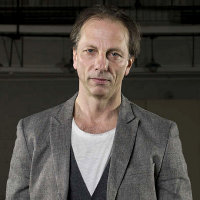 |
Krzysztof Pastor, 1956– . Polish choreogapher.
Beginning his career as a dancer himself, he has achieved lasting success as a choreographer, notably with the national ballet companies of the Netherlands, Lithuania, and his native Poland.
|
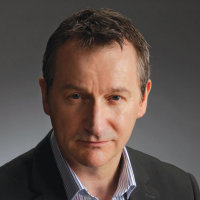 |
David Bintley, 1957– . English choreogapher.
Sir David Bintley began his career as a dancer with the Sadlers Wells Ballet. This later became the Birmingham Royal Ballet, the company which he headed from 1995 to 2018, and for which he created over two dozen new works.
|
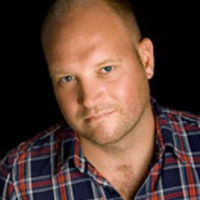 |
Paul Englishby, 1970– . English composer.
Englishby is an award-winning composer for film, television, and the theatre, including several years as an associate artist with the Royal Shakespeare Company.
|
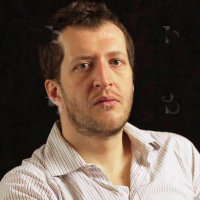 |
Thomas Adès, 1971– . English composer, pianist, and conductor.
Hailed as a musical polymath to equal only Benjamin Britten, Adès became the artistic director of Britten's own Aldeburgh Festival, 1999–2008. But his style, in many genres, is emphatically his own. His two large operas, The Tempest and The Exterminating Angel, have both received major productions at the Royal Opera House Covent Garden and the Metropolitan Opera in New York.
|
